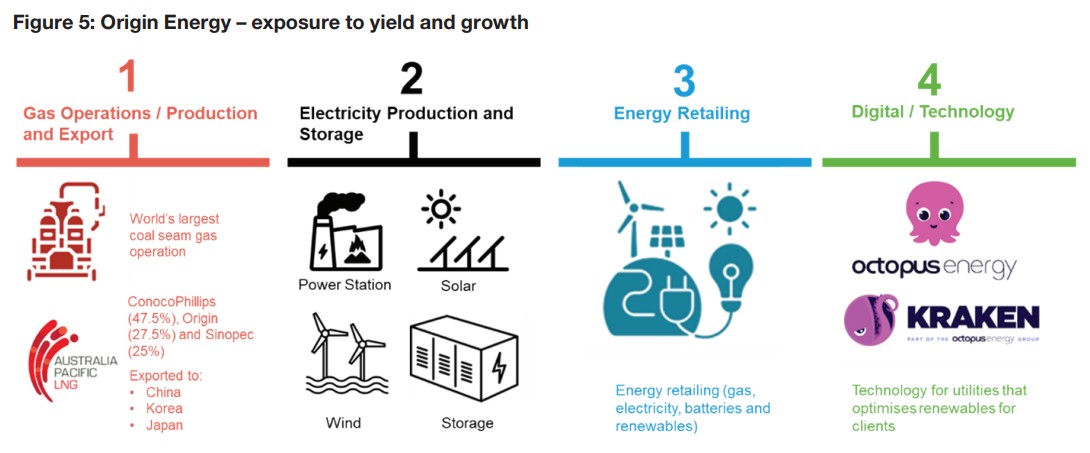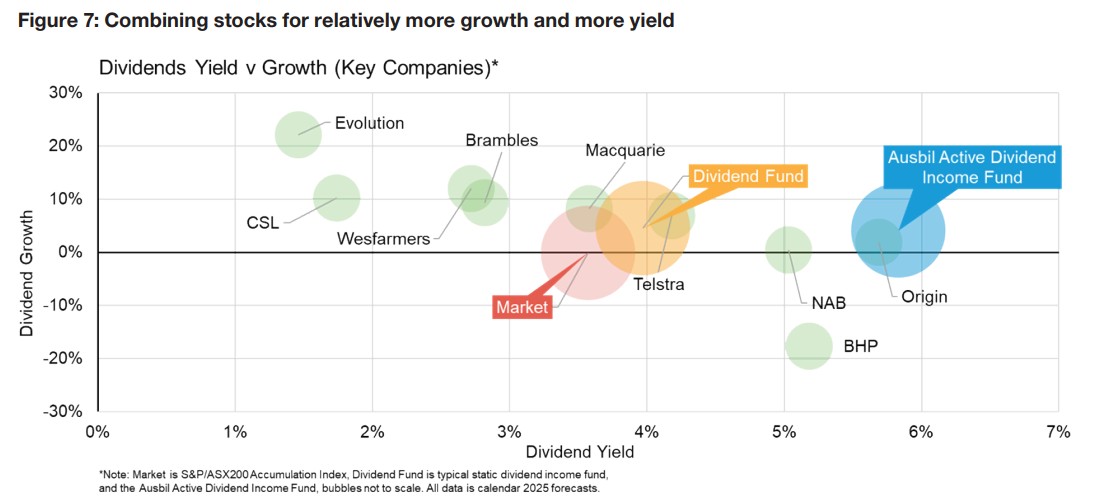How active dividend investing can boost yield and achieve growth
Key points:
- Income investing in equities is an ideal hunting ground for active investment strategies given the
idiosyncratic nature of dividends.
- Dividend payments are highly concentrated by company and sector based on dollars paid.
Banks, resources and energy companies pay the ‘lion’s share’ of dividends, but they are cyclical
sectors whose dividends rise and fall as economic growth rises and falls.
- Dividend yield for the S&P/ASX 200 is currently around 3.6% without grossing up for dividends,
but tends to average 4% long term, and can reach 7% or more when grossed up for franking
credits(1) in an active dividend income strategy.
- An active approach to dividend income investing can achieve both decent dividend yields and good dividend growth. This is why we believe an active approach can adjust for both opportunity and risk better than a passive approach.
Where do dividends come from?
The Australian market is an interesting one when it comes to dividends, particularly as it is extremely concentrated in terms of who pays out the dollars. The top seven companies paid over half the dividends in calendar 2024, which is pretty much the case most years (Figure 1). This included the four major banks, BHP, Fortescue and Woodside Energy Group.
That is, this ‘magnificent seven’ paid more in dividends than the other 193 companies in the S&P/ASX 200 combined.
Looking at it another way, if you split the index in half, the 100 highest dividend payers paid 97% of all dividends paid, with the other 100 companies accounting for just 3% of the total.
The concentration of dividend payers is not just at the company level, but also at the sector level (Figure 2). Banks make up 30% of the dividends paid, and when you add in the big three miners, BHP, Rio Tinto and Fortescue, you are again very close to 50% of the dividends from the financials and materials sectors.
Add in the oil and gas companies in the energy sector, and other metals and mining in the materials sector, and we get almost 60% of dividends by dollars paid coming from just banks and resources.
This concentration is a challenge for investors because of who is paying them. Banks are the most geared companies in the marketplace, and while they are safe in concept, their leveraged loan books are sensitive to the economic cycle and, by definition, so are their dividends. By way of example, you may remember most of the banks having to suspend their dividends during the global pandemic.
Resource companies are dependent on commodity prices, which can also be extremely volatile. BHP is still paying a decent dividend, but the interim dividend it paid in the first half of 2025 was only one-third the size of the one it paid just two years ago.
Just buying a few of the largest dividend payers is not a reliable source of steady income because banks and resources are cyclical and their dividends are likely to rise and fall in unison as economic growth rises and falls.
More is needed to form an equity income portfolio. The Ausbil Active Dividend Income - Wholesale was launched almost seven years ago and, so far, it has managed to distribute over 7% in income to clients each financial year – that is after fees and including franking credits(2) .
For the past 50 years, the cash dividend yield of the Australian market has generally ranged between 4% and 6%, making a 7% distribution yield including franking credits a reasonable target for a range of investors. However, the current dividend yield of the S&P/ASX 200 has fallen to around 3.5%.
The good news is that this has not been caused by companies slashing their dividends. Rather, while we can see in Figure 3 that dividends per share have followed earnings down slightly over the past two years, largely due to the fall in commodity prices, the main driver of the recent reduction in dividend yield has been the general increase in the price of the market, causing the dividend yield to be lower as a result.
What is the outlook for dividends?
Gross dividend yield, before the inclusion of franking credits, tends to revert to its long-term average of around 4.0%. For some perspective on where the dividend growth is generated, Figure 4 illustrates the sector contribution by dollar amount (represented by bubble size), against dividend yield and dividend growth.
Looking back at banks and resources, which make up almost 60% of the total dividends paid, you can see that these sectors offer good dividend yields. However, at the time of writing, they are not offering much dividend growth at this time in the cycle.
By contrast, some sectors are offering decent dividend yields and modest growth, including telecommunications, general insurance, diversified financials, consumer discretionary and even real estate investment trusts (REITs).
When assessing what is available in dividend yield and growth, it is important to look at Ausbil’s Active Dividend Income Fund dual mandate: to deliver a portfolio yield greater than the market yield and to outperform the market in terms of total return. A complete active dividend income strategy needs an optimised exposure to many of the sectors in Figure 4 to achieve this dual mandate.
Some important observations can be made from Figure 4. Firstly, the market average is currently at 3.6% dividend yield but with no growth. This will change of course moving forward. There are a lot more sectors and companies to the left of the market average than there is to the right, meaning that many are dragging down the yield at the moment.
In fact, around two thirds of ASX 200 companies have below average dividend yields at this point in the cycle. This leaves just one third of sectors paying above average dividends. This can be a real challenge for dividend investors looking for above-average income, and it is clear from Figure 4 that if you just chase the highest yielding sectors, you will sacrifice returns by the inclusion of many sectors that are actually delivering negative dividend growth.
The challenge for all income investors in equities is that it is hard to achieve both decent dividend yields and strong dividend growth. This is why we believe an active approach can adjust for this better than a passive approach.
What does a good dividend paying company look like?
The first thing is to look for companies that do offer high dividends, above market growth and exposure to long-term thematics that will help drive the growth in their business and earnings. You may have heard about Wesfarmers and Telstra as classic dividend stocks, but one that is not often discussed as a dividend stock is Origin Energy (ASX: ORG) (Figure 5).

Origin Energy is an interesting study of dividends with three distinctly different parts to the business, variously contributing to yield and growth. The first part is the gas business, which is one of the world’s largest coal seam gas producers.
This business is profitable with long-term contracts that provide strong cash flows. These cash flows are enough to pay a decent dividend for the company as a whole and contribute to the yield.
The second part of the business is the electricity business. Origin’s competitive advantage is that it is both a producer and a retailer. Being vertically integrated allows it to maintain its margins in the face of competition and rising input prices.
Interestingly, Origin effectively uses the cash produced by the electricity business for future growth rather than for dividends; that is, it can reinvest in business growth that compounds into further yield and dividend growth.
Origin is rolling out an internally funded battery capacity that connects to the grid. Batteries are profitable as they can generally recharge for free on sunny days when the grid is full of solar power, then provide that electricity back to the grid at peak times when it is most expensive.
The third part of Origin’s business model is a digital technology business called Kraken, which optimises energy use for clients. It is part of a company called Octopus that is privately owned.
Kraken is a fast-growing tech business success story. It is on track to reach 100 million customers and A$1bn of revenue by 2027. If it was publicly listed, it could trade on similar multiples to other tech companies, and a higher multiple than its parent, Origin.
At Octopus’s latest funding round in 2024, the whole business was valued at approximately A$14bn. Origin owns 23% of Octopus, which should be worth around A$4bn. But because the business contributes very little to Origin’s profits, the market appears to be ascribing next to no value to it all. This provides significant upside potential to our valuation and is a key driver of future dividend growth.
When you put it all together, we believe that Origin is an excellent business with strong dividends, earnings growth and an upside to its valuation that can ultimately feed into capital appreciation for investors.
Can equities generate a steady flow of income across the year?
In addition to finding companies that can generate dividend yield and dividend growth, an active approach can harvest dividends across the year to create a monthly income profile for investors (Figure 6). Listed companies pay dividends in different months on different year-end dates, making it possible to maximise yield and franking credits through tactical allocation.
In essence, with an active investment approach, we can take advantage on the fact that not every company pays dividends on the same date. Figure 6 breaks down all the ASX 200 dividends for calendar 2024 by the month in which they are paid (or more precisely, by the ex-dividend dates when shareholders become entitled to the dividend).
As can be seen, rather than six-monthly dividend payments, there are three distinctly different dividend paying periods, each corresponding to different groups of stocks. Firstly, companies with the standard 30 June balance date are in green.
Conveniently, they split their dividends across two separate months. Secondly, shown in red are the three major banks, other than CBA, and Macquarie Group, which operate on non-standard balance dates. Finally, REITs and infrastructure stocks, in orange, round out the other months, representing some 30 companies or 15% of S&P/ 200 Index.
To generate excess dividend yield and to gather a larger portion of franking credits, we hold the portfolio of companies that we like for total return reasons, but then increase the weight in the ones that are paying a dividend in the month that they are paying their dividends.
The way the numbers work, if we increase the weight of the companies that are paying their dividends by 10% of the portfolio in each of these eight months, by the end of the year, we will have around 50% more dividends than the index. This dividend structure enables us to distribute dividends to investors on a monthly basis.
What is the benefit of actively managing an equity income portfolio?
Zooming back out from individual companies to how an active dividend portfolio might look shows the benefit of combining similarly good dividend companies like Telstra, Wesfarmers and Origin into active portfolios (Figure 7).

By combining the best dividend yield and growth names in an active portfolio, with the ability to tactically harvest dividends and franking credits, we can generate approximately 2% higher nominal dividends than the index, but still with almost the same amount of growth, as illustrated by the blue portfolio in Figure 7.
This has seen the Ausbil Active Dividend Income Fund able to distribute at least 7% per annum after fees, and including franking credits, since its inception in 2018. Moreover, rather than just pay two distributions a year, we are able to smooth the dividends across the year and distribute income to investors in every one of the 12 months.
This effectively illustrates the advantages of active dividend investing. The portfolio should be able to deliver a better outcome for dividend-focused investors than relying on any individual company or even a static group of companies chosen on ‘passive’ selection and exclusion.
Are there risks with investing for dividends in equities compared to holding term deposits or bonds?
The key risk in generating dividends from equities is the risk of temporary drawdowns and market events. Of course, investors that can hold investments through market recovery can ride out any temporary hits to prices. Earnings growth surprises in stocks can impact dividends and are a risk with holding single-income positions.
A portfolio approach to active income investing can help reduce the impact of a single stock on the overall outcome, and the diversification across sectors can help cushion the impact of market events.
For these reasons, we believe the best results are achieved by taking a long-term view on income investing that allows for ructions in the price of shares, but also offers the advantages that come with adding to quality income holdings during times of weakness at better prices.
Ausbil Active Dividend Income Fund
Gain exposure to an actively managed portfolio, predominantly made up of listed Australian equities with tax effective income, which are primarily selected from the S&P/ASX 200 Index constituents.
5 topics
1 stock mentioned
1 fund mentioned
%20copy%20etched%201.jpg)
%20copy%20etched%201.jpg)